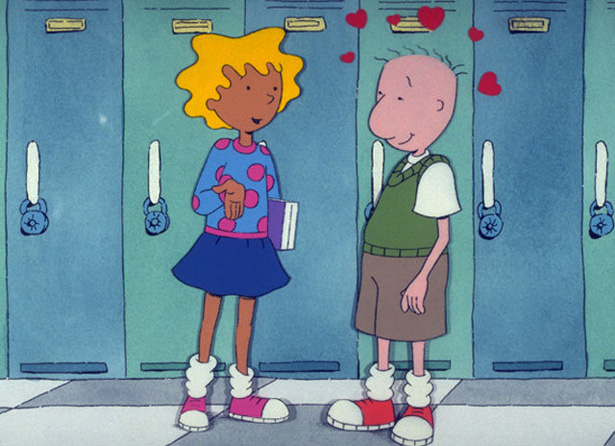'The '90s Are All That' and the Ever-Accelerating Nostalgia Machine
Looking back longingly on the not-so-distant past is nothing new—it's just happening faster now

Nickelodeon
I remember the first time I felt old. It happened when the kids I was babysitting plunked down on the couch to watch their favorite after-school TV program: a re-run of Saved by the Bell. They liked the show, but mostly for its unintentional humor. They found everything about it—the clothes, the hair, the schlocky theme music, the giant telephones—hilarious. It was the first time I felt the shadow of a younger generation encroaching, reducing the beloved things of my childhood to kitsch. I was, at the time, 18 years old.
Which is why I felt oddly triumphant when cable channel TeenNick announced that, due to popular demand, it was going retro with a block of programming called "The '90s Are All That." It seemed like a kind of victory—a statement that the 20 and 30-somethings of the world will not go gently into our pop culture twilight years, shuffled ignominiously aside by the hordes of Bieber-loving tweens. The midnight to 2 a.m. slot, which includes Nickelodeon's '90 staples All That, Clarissa Explains It All, and Doug, has proven to be a huge hit for the network, averaging more than 500,000 viewers in its premiere. This means that a lot of young-ish adults are staying up very late on school nights to partake in the nostalgia fest.
More on Retro Culture | |
|---|---|
 NSYNC | After the Boy-Band Boom |
 Reuters | Have the Rolling Stones Been Dethroned? |
 Copyright Alfred Wertheimer | The Elvis You Didn't Know |
The programming block devoted to the decade of flannel and angst initially set off some eye-rolling over the idea of 18-to 34-year-olds anxious to reclaim their lost youths. But television that taps into a longing for eras not-so-long-past is a staple of pop culture: Happy Days invoked the wholesomeness of the '50s when it first aired in 1974. Beginning in 1988, The Wonder Years poignantly filtered the social turmoil of the late '60s through the eyes of sensitive suburban pre-teen Kevin Arnold. That '70s Show launched in 1998, and remained on the air almost as long as disco was popular, and the teenage misfits of 1999's Freaks and Geeks navigated high school at the dawn of the '80s. In the early '00s, VH1 milked its popular I Love The '80s series, providing numerous tours through the decade led by celebrities both great (Lionel Richie) and small (Hal Sparks).
By that measure, the '90s revival has arrived right on schedule, and seems to have found a welcoming home on cable television. In addition to TeenNick's well-publicized foray into '90s nostalgia, the Sundance Channel is currently airing re-runs of the groundbreaking teen drama My So-Called Life, and IFC network scored a hit with the quirky first season of Portlandia, a gently mocking tribute to the city where the dream of the '90s lives on. And for those whose nostalgia is unsated by an insomniac night spent watching Clarissa explain it all over again, MTV announced that it is bringing Beavis and Butt-head back with new episodes in the fall.
All of this indicates that while the nostalgia machine isn't new, it is speeding up, powered by a generation that is routinely accused of refusing to grow up. Consider that back in the early '90s, much of Nickelodeon's late night programming dated back to the black-and-white era. In addition to Clarissa and The Cosby Show, I grew up on I Love Lucy and the Mary Tyler Moore Show. I was bitterly disappointed when I learned that The Monkees had originally aired nearly 20 years before I was born, and that Davy Jones was therefore way, way too old for me. But television networks now cater to a demographic whose young lives have been defined by the ubiquity of pop culture, and who never lived in a world without cable television. It's unsurprising, given the vastness of the media universe, that the definition of "classic TV" has jumped forward a few decades. Nick at Nite currently airs the The George Lopez Show, Home Improvement, and The Nanny. (Is it possible that anyone was longing for the return of Tim "The Tool Man" Taylor?)
Much has been made of the role that social media played in bringing the so-called Nick classics back to the air. Facebook groups, Twitter chatter, and YouTube videos dedicated to the old favorites reportedly convinced network executives that it had an eager audience primed for the revival. It's hard to say whether the current crop of young adults is more nostalgic for their youths than the ones that have come before, or if they now simply have the tools to declare it—emphatically. Pop culture is more interactive than ever, and Netflix, YouTube and Hulu keep the flame alive long after beloved shows have gone off the air. An Internet-savvy generation has effectively harnessed the power of mass communication to tell the world exactly we want: the comfort of our childhoods airing nightly on cable TV.
The '90s craze may be the product of a prematurely nostalgic generation, but even more so it's a natural evolution in a pop culture cycle that both surges forward and recycles itself at dizzying speeds. And anyway, the joke will soon be on us. At this rate, the High School Musical reunion tour can't be far off.